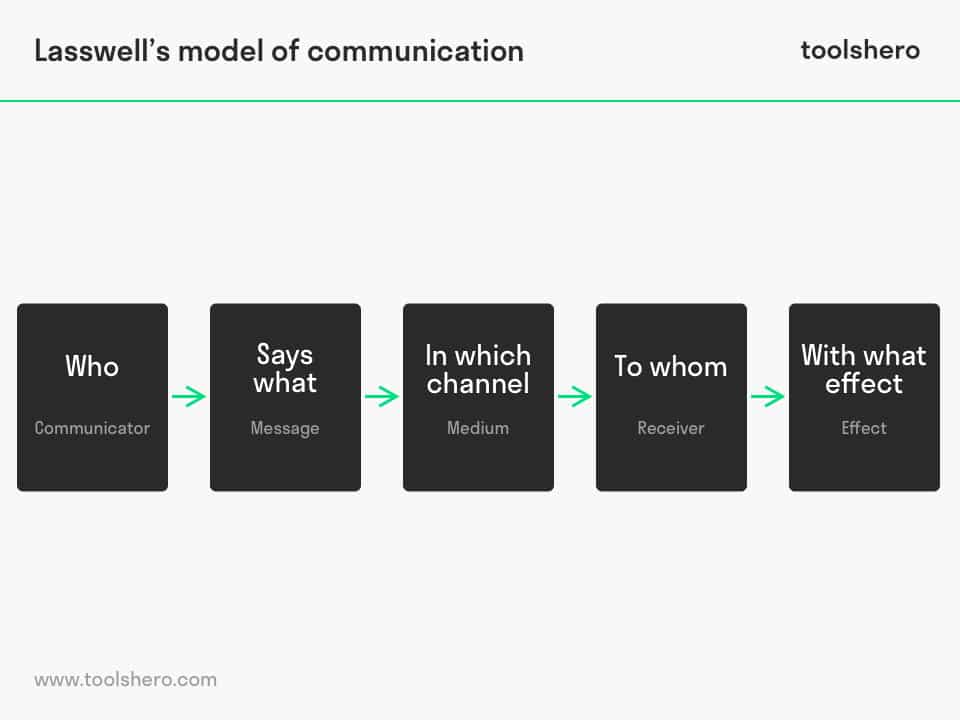Lasswell Communication Model

Lasswell Communication Model: this article describes the Lasswell Communication Model in a practical way. After reading you will understand the definition, meaning and basics of this powerful linear model of communication.
What is the Lasswell Communication Model?
American sociologist and psychologist, Harold Lasswell is best known for his linear model of communication that he developed in 1948.
The Lasswell model of communication (also known as Lasswell’s communication model) describes who is saying something, which channel is used to convey the messages, who the message is aimed at and what effect the message has. Communication sciences and public relations still often use this model, making this a classic sender receiver model.
Lasswell Communication Model : five components
The Lasswell Communication Model describes verbal communication and consists of five elements. Who says What, in Which channel, to Whom, with What effect?
This model is also called a ‘linear model of communication’, ‘uni-directional process’ or ‘action model, because it describes a one-way process within communication. It is seen as one of the most influential communication models. The model consists of five components, that are used as an analysis tool for evaluating the entire communication process. The previous ‘W’ questions are the basis for these components. The answers to these questions provide insight into the communication between people.
The Lasswell Communication Model consists of the basic questions below, aimed at a component and the gaining of an analysis:
Who?
Component: This is the communicator, also called the sender, who formulates and spreads a message. The sender can also be an intermediary.
Analysis: This is about a management and audit analysis, that helps the sender to have the power to communicate.
What?
Component: This is the content of the message or the message that the sender spreads.
Analysis: The content analysis is related to the aim of the message and/or the secondary intent.
Which channel?
Component: The channel describes the medium or media that is/are used to convey and spread the message. The medium can consist of several communication tools, mass media and social media.
Analysis: The media analysis shows which medium is best used to convey a message to the receivers as effectively as possible.
To whom?
Component: This describes the receiver(s), such as a target group or an individual. With mass communication, there’s an audience.
Analysis: The target analysis shows who the message is meant for and how they are best reached and/or influenced.
Which effect?
Component: The effect is the result the message leads to. The so-called triangle of success ‘knowledge, attitude, behaviour’ is often used to describe the desired effect.
Analysis: The effect analysis will need to be started beforehand, so the messages can be aimed at and fitted to the target audience.
A Lasswell Communication Model example
Communication can be understood as more than Lasswell’s linear communication model. The model can work really well when providing communication advice for organisations, by answering all five questions. This way, a communications advisor or marketer more easily gets an idea in advance about which concrete campaign should be carried out. Such a campaign plan states which message is sent via which channels and to which specific target audience in order to reach the desired effect and keep the lines of communication open between the organisation and its target groups. This is illustrated by the practical example below:
Imagine a large perfume chain that wants to reach a younger audience aged between 15 and 25 years old. Up until now, their customer base has been women between 25 and approximately 55 years old. Research has shown that especially young girls and women are also interested in make-up and perfume, but that they prefer not to visit shops, but rather prefer to look for products online.
For the perfume chain, this is a new challenge that Lasswell’s communication model can help them with. The five components of the Laswell Communication Model are used and each corresponding question is answered. In doing so, advice is formed and can be used to develop the campaign:
1. Who is communicating?
The perfume chain themselves. They want to present themselves as a modern company that also offers products online.
2. What needs to be communicated?
The perfume chain has opened an online shop and is now active on social media. The online shop offers a wide range of make-up and perfumes from well-known brands and orders are delivered within 24 hours. The language use will be hip and short and in the 2nd person singular (you), to make a connection and make the young target group feel involved.
3. Which channel is going to be used?
Other than large billboards advertising the opening of the online shop, there will also be investment in Facebook advertising as well as other social media, such as Twitter and Instagram.
4. Who is the message intended for?
These are girls and women between 15 and 25 years old who don’t go to perfume shops, but often order things online.
5. What effect does the campaign need to have?
The goal is for the target group to subscribe to the newsletter via Facebook or the website, so they will receive weekly offers and more quickly decide to order via the Internet.
Lasswell Communication Model = Mass communication
The Lasswell Communication Model was primarily deigned to analyse mass communication. However, it is also applied to interpersonal and group communication; as is also clear from the previous example.
When Lasswell developed the model in 1948, it was meant to study media propaganda from countries and businesses. In that time, only the rich could use mass media like television and radio.
Newspapers were not read by everyone, simply because subscriptions were too expensive. It was from this perspective that Lasswell came up with the concept of effective mass communication; the relationship between the presentation of the message and how this generates different effects. The effect of a message can also be seen as feedback.
Despite the fact that the model was specifically designed for mass communication, it can nowadays also be applied to different media and new fields, such as the Internet, social media and campaigning.
Now it’s Your Turn
What do you think? Is the Lasswell Communication Model applicable in your daily work? Do you recognize the practical explanation or do you have more additions? What are tip for improving your communication skills?
Share your experience and knowledge in the comments box below.
More information
- Lasswell, H. D. (1951). The policy orientation. Communication Researchers and Policy–Making.
- Lasswell, H. D. (1972). Communications research and public policy. Public Opinion Quarterly, 36(3), 301-310.
- Rogers, E. M. (1994). History of communication study. Free Press.
How to cite this article:
Mulder, P. (2018). Lasswell Communication Model. Retrieved [insert date] from Toolshero: https://www.toolshero.com/communication-methods/lasswell-communication-model/
Published on: 06/06/2018 | Last update: 05/19/2022
Add a link to this page on your website:
<a href=”https://www.toolshero.com/communication-methods/lasswell-communication-model/”>Toolshero: Lasswell Communication Model</a>








2 responses to “Lasswell Communication Model”
Yeah to some extent its applicable since the nature of my work is public dealing at hospital where iam supposed to be well informed in order to pass the right information to public.
Thank you for your comment, Raji